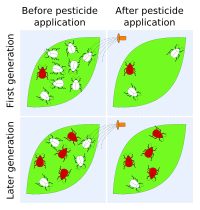
Photo from wikipedia
BackgroundIndoor residual spraying (IRS) and long-lasting insecticidal nets (LLINs) remain the cornerstones of malaria vector control. However, the development of insecticide resistance and its implications for operational failure of preventative… Click to show full abstract
BackgroundIndoor residual spraying (IRS) and long-lasting insecticidal nets (LLINs) remain the cornerstones of malaria vector control. However, the development of insecticide resistance and its implications for operational failure of preventative strategies are of concern. The aim of this study was to characterize insecticide resistance among Anopheles arabiensis populations in Ethiopia and describe temporal and spatial patterns of resistance between 2012 and 2016.MethodsBetween 2012 and 2016, resistance status of An. arabiensis was assessed annually during the long rainy seasons in study sites from seven of the nine regions in Ethiopia. Insecticide resistance levels were measured with WHO susceptibility tests and CDC bottle bioassays using insecticides from four chemical classes (organochlorines, pyrethroids, organophosphates and carbamates), with minor variations in insecticides tested and assays conducted between years. In selected sites, CDC synergist assays were performed by pre-exposing mosquitoes to piperonyl butoxide (PBO). In 2015 and 2016, mosquitoes from DDT and deltamethrin bioassays were randomly selected, identified to species-level and screened for knockdown resistance (kdr) by PCR.ResultsIntense resistance to DDT and pyrethroids was pervasive across Ethiopia, consistent with historic use of DDT for IRS and concomitant increases in insecticide-treated net coverage over the last 15 years. Longitudinal resistance trends to malathion, bendiocarb, propoxur and pirimiphos-methyl corresponded to shifts in the national insecticide policy. By 2016, resistance to the latter two insecticides had emerged, with the potential to jeopardize future long-term effectiveness of vector control activities in these areas. Between 2015 and 2016, the West African (L1014F) kdr allele was detected in 74.1% (n = 686/926) of specimens, with frequencies ranging from 31 to 100% and 33 to 100% in survivors from DDT and deltamethrin bioassays, respectively. Restoration of mosquito susceptibility, following pre-exposure to PBO, along with a lack of association between kdr allele frequency and An. arabiensis mortality rate, both indicate metabolic and target-site mutation mechanisms are contributing to insecticide resistance.ConclusionsData generated by this study will strengthen the National Malaria Control Programme’s insecticide resistance management strategy to safeguard continued efficacy of IRS and other malaria control methods in Ethiopia.
Journal Title: Malaria Journal
Year Published: 2017
Link to full text (if available)
Share on Social Media: Sign Up to like & get
recommendations!